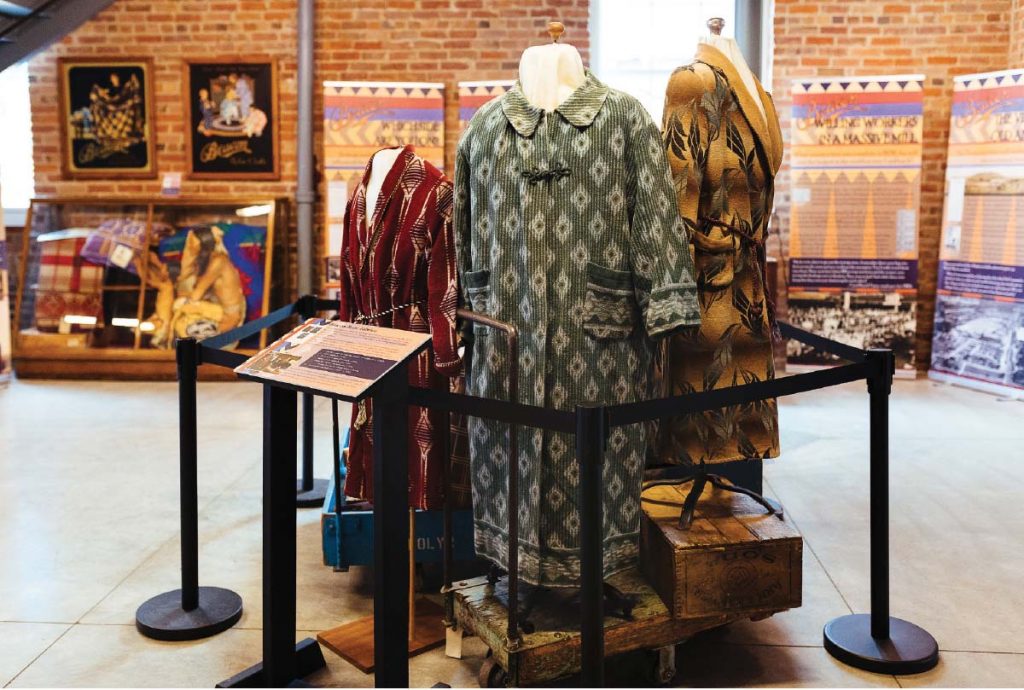July 26, 2019
by Rachel Pressley, Asheville Made

Photo by Rachel Pressley
To coincide with the release of Rebecca Williams’ documentary Blanket Town, about the Beacon Blankets Mill in Black Mountain, the Swannanoa Valley Museum & History Center is hosting a multimedia exhibit on the mill and its iconic textile products.
The New England textile company originally came from New Bedford, Massachusetts, in the 1930s to escape unionizing efforts during the Great Depression. It quickly became the heart of Swannanoa and the largest mill of its kind in the world, employing 2,200 people in the area and drawing tourists from all over — which essentially boosted the economy. “The farming economy was getting more unpredictable,” states Anne Chesky Smith, director at Swannanoa Valley Museum & History Center. “Having factory-mill wages meant that families could get housing, credit at the company store, and other benefits, so locals began finding work through Beacon.”

Photo by Rachel Pressley
The company, explains Smith, “had its hands in everything, so when it closed in 2002, it devastated the people who still lived in the mill village.” Over one year after the mill closed down, an arsonist set the structure on fire. “It was like watching their own home burn down,” Smith adds. Saddened by the loss of such a large part of the community, locals went back to the site to collect bricks as souvenirs.
The family-owned company, originally known for spinning yarn from waste in the early 1900s, quickly gained popularity once it arrived in the Swannanoa Valley. Back in Massachusetts, Beacon Blankets used cotton flannel to make the blankets and robes. “Their unique ombré technique made with raw cotton and wool was what made them stand out,” says Smith. “You just didn’t see that smooth of a transition between colors in other blankets made during the time.” The company produced this style of blankets until the 1950s, when they switched to synthetic blends due to cost efficiency. Though the company continued to manufacture similar products, the ombré pattern was never made by Beacon Blankets after the switch to different materials.
In the ongoing exhibit, Beacon Blankets: The Mill, narrative panels and displays are set up around the museum’s first-floor gallery to examine related topics, including the long history of the textile industry; unionizing efforts; worker strikes; the company’s move south for cheaper labor and other resources like cotton, water and timber; and Beacon’s controversial (and deceptive) use of the term “Indian Blankets” to market colorful geometric designs. Visitors can read the full history, see collections of original blankets — now sought-after collectibles — and robes, and try a hands-on approach at weaving fibers. A section of Williams’ documentary about Beacon is also on view. “This exhibit has always been on the docket because Beacon is such an important part of Swannanoa history,” Smith tells Asheville Made.
The Swannanoa Valley Museum & History Center, 223 West State St., Black Mountain. “Beacon Blankets: The Mill” will be on display through Nov. 2. Museum hours are Tuesday-Saturday, 10am-5pm, or by appointment. Admission by donation is suggested ($5). Members, students, and children under 18 are free. For more information, visit history.swannanoavalleymuseum.org or call 828-669-9566.